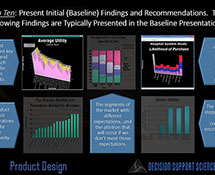Product Design
/ Re-Design
IF YOU BUILD IT RIGHT...THEY WILL COME: PRODUCT DESIGN / REDESIGN.
(2 minute video)
(Be sure to run the video in fullscreen by clicking on the icons below.)
IMPROVING SALES BY 10-200%. AT LOWER COST. IT'S TIME. (INTRO VIDEO.)
THE LIMITATIONS OF CONVENTIONAL APPROACHES
PRODUCT DESIGN USING DECISION SUPPORT ENABLEMENT (DSE)
THE PHASES and STEPS OF A DSE PRODUCT DESIGN ENGAGEMENT
KEY BENEFITS
EXAMPLE CLIENTS
CONTACT / QUESTIONS
VIDEO
CENTER
CONSULTING
PLATFORMS
SOFTWARE
SOLUTIONS BY INDUSTRY
THE LIMITATIONS OF CONVENTIONAL PRODUCT DESIGN APPROACHES
Conventional consulting approaches demonstrate one or more of the following limitations:
-
The
data
collected in the survey is inadequate. The measurement system:
- Doesn’t collect the entire spectrum of measures (i.e. behaviors, intention, gap bet. performance and expectation, performance, importance, expectation; i.e. the "B.I.G P.I.E.")
- Doesn't find real-world behavioral thresholds (e.g. purchase, switching, retention, etc.)
- Doesn't reproduce the real-world trade-offs consumers face in the actual purchase setting.
- Doesn't adapt to prior answers...so the survey doesn't optimally zero in on a consumer's values.
- Doesn't recognize that very few customers can accurately tell you "how important" key drivers are! But ALL can recognize what is important when they see it. (Hence trade-offs).
- Doesn't produce E-customers (copies of the consumer that save ~90% of follow-on survey costs.)
-
The
decision support
system:
the tool that "sees and mines" the data:
- Doesn’t allow full automated significance scanning of all data dimensions (i.e. the “B.I.G P.I.E.")
- Doesn't provide analysis down to “segments of one” - the individual consumer.
- Doesn't discover how much attractiveness ("utility") is enough to create a desired behavior.
- Doesn’t use hundreds of algorithm variations to find the one that best solves for the importance of each level of each attribute for each customer (i.e. level utilities.)
- Doesn't allow manual "what-iffing" (changing key driver performance) to see the effect on share.
- Doesn't automatically test millions of change strategies to capture the most consumers overall.
- Doesn't identify the optimal key driver mix for other outcomes (switching, retention, etc.)
- Doesn’t identify the mix that will capture most customers at the lowest cost (“bang for the buck”)
- Doesn’t achieve segmentation, positioning/ branding and innovation outcomes at the same time.
-
The
consulting firm
:
- Imagines that they are your equity partner - and charges you that way.
- Gives you the fish (the answer)...but not the fishing pole (the decision support system).
REINVENTING PRODUCTS USING DECISION SUPPORT ENABLEMENT (DSE)
What if a Far Better Approach to Risk-Mitigating Product Design Existed? One that:
- Linked to real world outcomes such as: Purchase, Sales/Revenue, Retention and Profit?
-
Retained all the truly useful capabilities of existing best practices such as:
- Accurate real-time isolation of the key drivers for every representative consumer?
- Full inferential analysis of all key drivers (importance, performance, expectation, etc.)
Moreover, What If That Approach Had the Ability to:
- Present any product....in any configuration... to your E-customers...and identify the product configurations that:
-
- Maximized preference (Preference modeling)
- Caused the maximal number of non-customers to switch to you (Switching modeling)
- Maximized existing product retention (Retention Modeling)
- Best protected you against competitive attacks (Blunting modeling)
- Maximized market share at the least cost (Price Partial modeling)
- Automatically build and test millions of potential product configurations to achieve these outcomes? Both for the whole market and for every segment?
- Be so turn-key that it could be run by non-experts in-house?
Decision Support-Enabled Product Design achieves all these outcomes. The result? Far more accurate product strategies...at a far lower cost. Delivered you way. That's enablement.
PHASES AND STEPS OF A DSE PRODUCT DESIGN ENGAGEMENT (Slide show)
(Click on the first icon below to start the slide show.)
KEY BENEFITS (Place your pointer over the benefits to see the short description.)

Decision Support-Enabled Product Design markedly outperforms conventional product design protocols. This differentiation is due to five key distinctives: 1) DSEPD uses a specialized survey design that obtains seven key categories of data 2) DSEPD calculates from that survey ultra accurate importance scores (utilities) for each respondent (see benefit three) 3) DSEPD obtains key behavioral thresholds that determine how much summed preference are required to get each individual respondent "off the dime" 4) DSEPD leverages an advanced analysis system that finds all significant differences in importance, performance and expectation 5) DSEPD uses goal solving simulators that yield real-world outcomes (RWO's).

Another primary reasons why our Product Design protocol outperforms other protocols relates directly to our adaptive survey system. Our adaptive surveying approach: 1) eliminates irrelevant attributes for each respondent 2) reproduces the real-world purchase environment 3) requires the respondent to make the same product feature trade-offs in the survey that they must make in real life 4) adapts in real time to prior choices to zero-in on that particular consumer's most critical values and it 5) discovers "how much" preference (summed importance) it takes to meet real-world thresholds (e.g. switching, purchase, etc.)

One of the central reasons why our product design protocol outperforms other approaches relates to our product design decisioning platform, ProductSolve™. In contrast to other systems, ProductSolve™ does not use a "canned method" to calculate its utilities. ProductSolve™, in fact, tests over 20,000 distinct combinations of algorithms, weightings, exponents and "TopK" cutoffs. Although this process is computationally intensive, it guarantees that ProductSolve™ empirically converges upon the utility set that best reproduces real-world purchase behavior.

Once we have 1) captured the value system (the importance scores) of each customer and have 2) captured "how much" additional preference is needed to "get consumers off the dime," then, in effect we have created an electronic copy of the customer: an E-customer. The advantage of an E-customer? E-customers respond as original customers do except they never get tired...and never need to be paid! When E-customers are placed inside market simulators they allow us to test millions of potential products per day. The result? More comprehensive risk-mitigation while lowering marketing spend.

The correct theory is necessary, of course, but in the final analysis commercial decision support platforms must predict real world outcomes (RWO's.) ProductSolve™, our core decision support system for product design, leads the industry in predicting real world outcomes. This reason? First, ProductSolve™ produces the most accurate respondent-level importance scores (utilities). Second, we use a proprietary approach to finding behavioral thresholds in the survey. Third, we exhaustively calibrate to real-world outcomes using both internal and external calibration techniques.

It has never been enough to just guess at an outcome.! Nonetheless, many simulation-based approaches only allow manual "what-iffing." In contrast, truly thorough risk-mitigation requires goal-solving. The goal solving built into ProductSolve™ is called Multi-Attribute Simulation Scanning or MASS. MASS automatically builds and tests millions of products to find the subset that produces critical real world outcomes (RWO's) such as maximal new customer capture, switching, etc.

One of most powerful capabilities build into our Product Design protocol is the ability to perform Marginal Benefit (MB) Modeling. The MB model combines a real world outcome model (e.g. new customer capture, likelihood of purchase, switching, retention, etc) with two types of cost data, cost to implement (CTI) and cost to serve (CTS) data. By using CTI and CTS, the Marginal Benefit Model finds strategies that maximize real world outcomes at the lowest cost. The MB model, quite literally, searches and solves for the changes to your product or service that will yield the maximal "bang for the buck."

Most marketers are aware that, quite frequently, the entire profit model from a product or service may arise from only one or two market segments. Accordingly, the decision support platform for Product Design, ProductSolve™ has the capability to automatically set up and scan for 1) significant analytical findings (e.g. importance, performance, expectation, etc.) and 2) optimal products across hundreds or thousands of market segments. The latter capability can be combined with goal-solving to automatically search and solve for product configurations within segments of customers that will produce optimal real world outcomes (RWO) for your product or service.

One of the most powerful features of our Product Design protocol is ProductSolve™'s ability to search and solve for things that no one would normally think of. It does this by automatically scanning any type of data (performance, importance expectation) and finding statistical differences between known or derived market segments. This remarkable capability, computer-aided significance scanning (CASS), finds natural breaks in the data that a) directly translate to new product ideas and b) provides insights into previously undiscovered market segments.

Unlike other approaches to product design, we don't rely on utility-based simulation models alone to risk-mitigate change. We use another complementary approach, as well, multivariate data reduction via InnovationSolve™. InnovationSolve™ accurately locates both brands and demand on the same landscape, a concept so insightful that it earned a main stage presentation at AMA's prestigious Annual Advanced Research Technique forum. Why? Simple! Demand is the missing link in most strategy systems. Demand (seen here as semi-transparent spheres) identifies where to build new products and HOW to message that innovation.
Develops New or Renewed Product Strategies That Simply Sell Better
Reproduces the Real World Purchase Environment via an Adaptive Survey
Yields the Most Accurate Drivers Using Hybrid Advanced Mathematics
Builds E-Customers...the Asset That Lies at the Heart of NCC Strategies
Produces Real World Outcomes
Implements Goal Solving
Identifies Changes That Maximize Profit at Minimum Cost (Marginal Benefit)
Identifies Optimal Segment Strategies
Mines All Significant Differences for All Market Measures Automatically
Performs Innovation Analysis (Moves into Areas of Maximal Market Demand)
<
>
EXAMPLE CLIENTS
Retail Banking
We have deployed over 20 national product design studies for five of the top 20 U.S. and Canadian banks.
Other Financial
We have deployed numerous national product design studies for leading mutual fund, investment firm, and thrift companies.
Retail Banking
Other Financial Services























